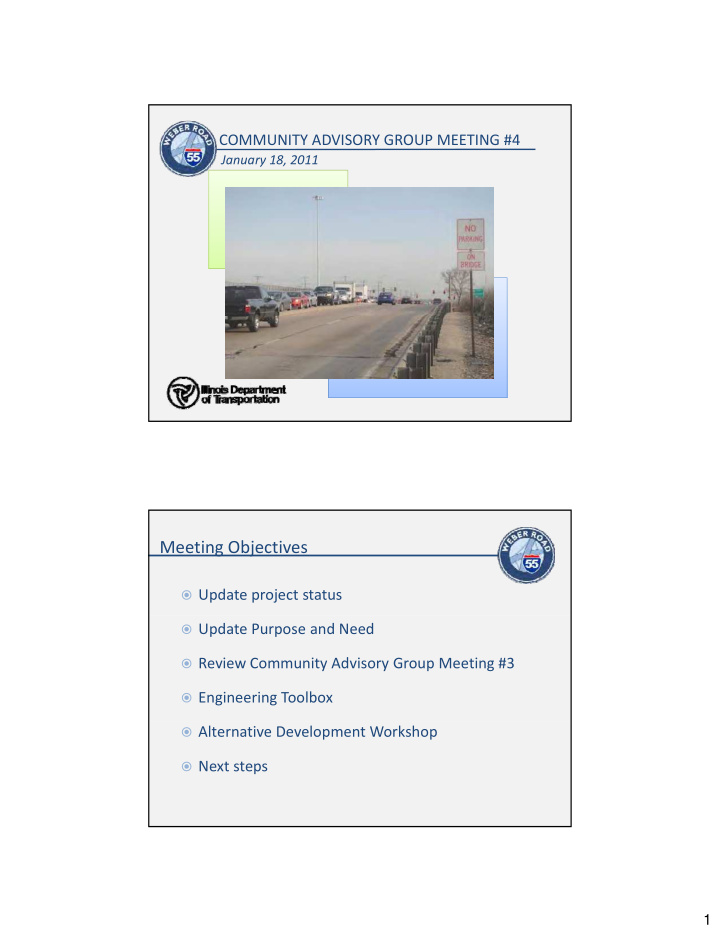



COMMUNITY ADVISORY GROUP MEETING #4 January 18, 2011 Meeting Objectives Update project status Update Purpose and Need Review Community Advisory Group Meeting #3 Engineering Toolbox Alternative Development Workshop Next steps 1
Project Status Purpose and Need Report PROBLEM STATEMENT • CAG WORKSHOP • COMMUNITY CONTEXT SURVEY PURPOSE AND NEED REPORT ENGINEERING ANALYSIS • CRASH DATA ANALYSIS CRASH DATA ANALYSIS • TRAFFIC DATA ANALYSIS PUBLIC AND AGENCY COORDINATION 2
WHAT IS THE PURPOSE AND NEED? Need is a tangible fact based problem ; i e a Need is a tangible fact based problem ; i.e. a transportation deficiency Purpose is an overarching statement of why you are pursuing the project; objectives that will be met to pursuing the project; objectives that will be met to address the transportation deficiency Purpose and Need Report Need: Address Operational Deficiencies Technical Analysis Problem Statement Stakeholder Input Traffic signal delay High volume turn Signals (traffic/ movements pedestrian) Unacceptable level of service on Weber Road service on Weber Road Inadequate lane Inadequate lane Street lighting/ Street lighting/ and I ‐ 55 ramps marking pedestrian lighting Merging issues Roadways compatible to existing businesses Poor signage Roadways compatible Traffic signal delay to existing commuting patterns 3
Purpose and Need Report Need: Improve Capacity Technical Analysis Problem Statement Stakeholder Input Projected increase in High volume of trucks Industrial centers and traffic volumes commercial areas No alternate north ‐ Substandard geometrics Substandard geometrics south routes south routes Commuter corridor Commuter corridor (travel lanes, Inadequate access to I ‐ Congestion and delay intersections) 55 Congestion Purpose and Need Report Need: Improve Safety Technical Analysis Problem Statement Stakeholder Input High number of crashes Motorist delay Traffic Safety Multi ‐ modal conflicts Prevents efficient access Congestion and delay High number of rear ‐ Congestion Handicap accessibility end and sideswipe Lack of pedestrian, Sidewalks and collisions ADA, and bike facilities pedestrian crossings Crashes data consistent Improve pedestrian Bike lanes/recreation with congestion access and bike path facilities No crosswalks or continuity continuous bike paths 4
Project Purpose The purpose of the proposed action is to address congestion and mobility problems in the Weber Road corridor identified in the study area, improve community connectivity, and improve access for commercial and residential users of I ‐ 55 and Weber Road Road. Project Purpose The purpose of the proposed action is to address operational , capacity and safety deficiencies of the interchange capacity , and safety deficiencies of the interchange at Interstate 55 and Weber Road in Will County, Illinois . 5
Project Purpose The purpose of the proposed action is to address operational, capacity, and safety deficiencies of the interchange at Interstate 55 and Weber Road in Will County, Illinois. Purpose and Need Report QUESTIONS 6
Review CAG #3 Identify Alternative Development Process Alternative Development Process p Context Context Define and Evaluation Define Preferred Evaluate Problem Criteria Alternative Alternatives Identify Stakeholders Considerations Considerations Stakeholder Considerations / Community Assets Environmental Considerations / Compatibility with the Environment Engineering Considerations / Transportation Needs Review CAG #3 Identify Alternative Development Process Alternative Development Process p Context Context Define and Define Evaluation Preferred Evaluate Criteria Problem Alternative Alternatives Identify Stakeholders Establish transportation performance measures Inventory existing environmental constraints Identify evaluation metrics 7
Review CAG #3 Identify Alternative Development Process Alternative Development Process p Context Context Define and Evaluation Define Preferred Evaluate Problem Criteria Alternative Alternatives Identify Stakeholders Develop initial alternatives with stakeholders Confirm alternatives meet Purpose and Need and compare transportation performance Eliminate low ranked alternatives Review CAG #3 Identify Alternative Development Process Alternative Development Process p Context Context Define and Define Evaluation Preferred Evaluate Criteria Problem Alternative Alternatives Identify Stakeholders Detailed engineering and environmental analysis of remaining alternatives Evaluate performance, impacts, and costs Recommend preferred alternative 8
Engineering Toolbox Interchange Improvements Weber Road Improvements Non ‐ Motorized Improvements Engineering Toolbox Interchange Improvements Weber Road Improvements Non ‐ Motorized Improvements 9
Interchange Improvements CLOVERLEAF CLOVERLEAF Free ‐ flowing traffic Large footprint Weaving sections Weaving sections Not pedestrian friendly Interchange Types I ‐ 55 at Lemont Road 10
Interchange Improvements Diamond Diamond Signal controlled intersections Smaller footprint Interchange Types I ‐ 88 at IL ‐ 59 11
Interchange Improvements Partial Cloverleaf Partial Cloverleaf No weaving Some free ‐ flowing movements Some signal control Smaller footprint in some quadrants Interchange Types I ‐ 80 at La Grange Road 12
Interchange Improvements Split Diamond Split Diamond Signal controlled intersections Access split at two locations locations Frontage road system Interchange Types I ‐ 290/IL ‐ 53 at Algonquin Road 13
Interchange Improvements Single Point Urban Diamond (SPUDI) Small footprint One signalized intersection intersection Large structure Interchange Types I ‐ 55 at Cicero Avenue 14
Interchange Improvements Diverging Diamond Diverging Diamond Small footprint Accommodates heavy left turn traffic Free flow Interstate entrances Driver unfamiliarity Interchange Types Diverging Diamond Interchange 15
Interchange Types Pioneer Crossing I ‐ 15 to Redwood Road, Utah Engineering Toolbox Interchange Improvements Weber Road Improvements Non ‐ Motorized Improvements 16
Weber Road Improvements Added Lane Added Lane Existing Lanes Lanes Additional Capacity Weber Road Improvements Lighting 17
Weber Road Improvements Raised Median Median Access Control Weber Road Improvements Physically Separated Turn Lanes Turn Lanes Channelization 18
Weber Road Improvements Additional turn lanes Improved traffic signal coordination Turn prohibitions Improved signage/striping p g g p g Pedestrian/Bicyclist accommodations Intersection Improvements Engineering Toolbox Interchange Improvements Weber Road Improvements Non ‐ Motorized Improvements 19
Non ‐ Motorized Improvements Improved Pedestrian Facilities Non ‐ Motorized Improvements Improved ADA Facilities 20
Non ‐ Motorized Improvements Improved Bicycle Facilities Non ‐ Motorized Improvements Real ‐ time traveler information Real time traveler information Variable/dynamic messaging 511 systems Adaptive signal control Trailblazer signs Intelligent Transportation Systems (ITS) 21
Alternative Development Workshop Alternative Development Workshop 22
Alternative Development Workshop Next Steps 23
Thank You! Community Advisory Group Meeting #5 Range of Alternatives TBD 24
Recommend
More recommend